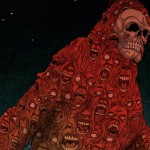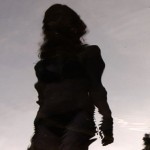Mythologies of Memory and Desire
Mythologies of Memory and Desire
An interview with Calvin Reeder, director of The Oregonian
By Kier-La Janisse
——————–
 I first heard of actor/director/musician Calvin Reeder through Jerkbeast (co-starring and co-directed with Brady Hall), a Seattle-based call-in public access show (2001-2002) in which a fictional rock band called Steaming Wolf Penis mocked callers in between bouts of grunge-metal thrashings full of deliberately moronic song lyrics (“looks like chocolate, tastes like shit”) and highlighted by the musings of titular papier-mache drummer (Caller: “What’s this show about?” Jerkbeast: “It’s about science.”). The show’s self-described premise: “30 minutes of pure, blinding hatred, directed at YOU, the viewing audience. Call in and secure places to buy levitra in canada visa try to out-swear us. You’ll find it rather difficult.” (which also brings to mind the curious fact that swearing, drug use and nudity are acceptable on many US public access stations!) Jerkbeast later spawned a feature film but the individual episodes are well worth seeking out.
I first heard of actor/director/musician Calvin Reeder through Jerkbeast (co-starring and co-directed with Brady Hall), a Seattle-based call-in public access show (2001-2002) in which a fictional rock band called Steaming Wolf Penis mocked callers in between bouts of grunge-metal thrashings full of deliberately moronic song lyrics (“looks like chocolate, tastes like shit”) and highlighted by the musings of titular papier-mache drummer (Caller: “What’s this show about?” Jerkbeast: “It’s about science.”). The show’s self-described premise: “30 minutes of pure, blinding hatred, directed at YOU, the viewing audience. Call in and secure places to buy levitra in canada visa try to out-swear us. You’ll find it rather difficult.” (which also brings to mind the curious fact that swearing, drug use and nudity are acceptable on many US public access stations!) Jerkbeast later spawned a feature film but the individual episodes are well worth seeking out.
After Jerkbeast he took a left turn aesthetically, eschewing the flatness and spontaneous pleasures of video for the more controlled, textured nuance of 16mm film with a series of short films – including Little Farm (2006), The Rambler (2008) and The Snake Mountain Colada (2009) – which played numerous festivals worldwide, gaining him a small cult following.
His debut feature The Oregonian premiered at Sundance in 2011, and interviews done at the festival show his reluctance to be professional cialis online categorized within a genre that is popularly (and wrongly) associated with that peculiar concoction of gore and humour. So our conversation brings up some interesting questions about what constitutes a “horror” film, something film exhibitors (theatrical and festival programmers) always find themselves trying to articulate and, at times, defend.
But is The Oregonian a “midnight movie”? Considering that midnight movies began with things as varied as El Topo, Eraserhead and Pink Flamingos, The Oregonian might fit into this club of bizarre and challenging films. But over time, as “midnight” films became easily accessible 24/7 through home video and the internet, the “midnight movie” has become less about the surreal and more about action and humour that will keep audiences awake in the wee hours –and it’s because of this that The Oregonian – a rather dreamy and shamanistic affair – has suffered from being placed in a timeslot more currently reserved for fare like Dead-Alive and or classic repertory titles like A Clockwork Orange, The Evil Dead and Pink Floyd: The Wall, the latter three of which are not especially fast-paced but benefit from their existing cult reputations.
The Oregonian may not have found its audience, but it certainly deserves one. Its hallucinatory forest is a remarkable bestiary full of creatures both human and inhuman, decadent, laughing and bound by fluids. The journey of its protagonists mirrors that of Reeder’s previous characters, all of whom seem to be on an undefined path to an indeterminate location, that lay, perhaps, in the subconscious. To start with Jerkbeast and end with The Oregonian is a jarring shift, but threads and similarities are there, and that journey is in itself pretty impressive. Now, read on…
————————-
– About The Oregonian, in a previous email you said to me that “it’s not a horror film, despite festivals’ best efforts to make it one”. Why do you not think of it as a horror film – and why do you think other people are categorizing it that way? I mean to me, it’s obviously a horror film – it’s kind of like a Northwestern backwoods Carnival of Souls.
I guess I was being a little flip blaming it on the festivals, I was wrong cialis levitra viagra compare to say it like that. Something about the combination of routinely being booked at midnight alongside more traditional horror narratives has colored a lot of folks’ perception of what the film might be. A lot of web site bloggers or whatever have gone in with that same loose notion as well. Thinking that since the blonde chick is covered in blood and brandishes a shot gun in the woods that they levitra generic ordering already have some expectation for the film. I’ve done everything in my power to erase that but it doesn’t seem to work. I do think a lot of festivals have done a price of propecia from canada nice job in their description of the film in their program guides, but again playing at midnight and the bloody girl picture seems to make it easy for people to just expect a horror film.
I have seen Carnival of Souls, but only once. I remember its beauty and sort of forgot the rest. I wouldn’t call The Oregonian a horror film because it simply wasn’t the prevailing wind. I wanted to make psychic mystery with inclinations of impressionism. Everybody bleeds, blood doesn’t have to signal horror. Red is a great color and making people bleed is a great way to bring that out. Color is a major theme in The Oregonian.
– While blood doesn’t have to signal horror, it does – when people see blood, they think horror. It’s a natural psychological connection because most people associate blood with something being undone, and things coming apart are frightening to us, even though they don’t always need to be.
I wouldn’t deny that I attempted to make the film scary at times and really stuck to a dreadful mood. Two of the films that most informed The Oregonian are Stalker and Fando and Lis. Surrealistic and tonal, movies that you think about in the morning before anything else gets in.
– What kind of story were you trying to tell with The Oregonian? As with your shorts, there are a lot of strangers, who act as signposts along the way on a weird journey.
That’s a big question intended for the movie to answer on its own. What kind of story did you get out of The Oregonian?
– It seems like a purgatorial journey. Like she died in a car accident and got lost among the spirits. I don’t know if she’s supposed to be dead or not but that’s how I read it. In what way does the particular location play into the story, symbolically or otherwise? I read one reviewer who compared it to Nicolas Roeg, which is kind of interesting considering Walkabout or Don’t Look Now in terms of the characters and their relation to the ethereal space around them.
Well, without giving away too much, The Oregonian takes place in many locations. The environment is a character and I don’t mean that in some Woody Allen “New York is character” kind of way. I mean that it changes, breaths and evolves in rhythm with Lindsay’s performance which is very much a metamorphosis. It’s deliberate and is a key to the film. I like Nicolas Roeg a bunch and probably don’t deserve to be compared to him.
Tell me about the sound design in your films – it’s like a lot of typically background noise is brought to the forefront and emphasized over more subtle natural sounds.
Well, I kinda hope that the sounds in there aren’t very typical at all. Some low tonal stuff is for sure but even there I feel we had our own way of doing it. I started building the sound design in the script writing process, the sounds in this movie are probably more important than its dialogue.
When I referred to the typically background noise, i didn’t mean to say that your sound design was ‘typical’, I meant they sounded like things you would typically not hear, like quiet background noises picked up by a contact mic and brought to the forefront and emphasized. Music is obviously a big part of the films – many characters are musicians, the original songs and music is kind of an echo-ey swamp fuzz country-folk (?) – including early use of The OCS (when they were still credited as such) – you also wrote and performed some of the songs yourself, one of your collaborators Jessica Hundley directed a couple of great music docs, and in the earliest thing I’ve seen of yours – the public access show Jerkbeast –you and Brady Hall are in a rock band with the paper mache monster of the title. So music has been a strong thread running through all your work. Did you come to movies somehow through your interest in music? Did music and sound come first and the visuals later? This is a long rambling non-question, sorry – I just wanted to get some comments on your musical background and how you think it plays into the films.
I didn’t go to college or anything but I spent a lot of time touring in bands The Intelligence and Popular Shapes. We were always classified as “art punk” I guess because we were interested in finding strange rhythms and sounds then smashing them into brain-damaged pop hooks. At the time a lot of garage music people were turned off by us because we were too arty and a lot of experimental and noise people thought we were too poppy, that was fine by us. I guess there is maybe a parallel there between the music I’ve played and the films I’ve made. Can’t go pleasing your judges or following some abstract set of rules that everyone has agreed upon. That mandate is theirs, not mine.
– You work with a lot of the same people on your films, but this isn’t just a backyard group of friends – some of them are quite busy and successful with their own film projects – does it get easier every time when you make films with the same people, and does that get hard to maintain as their own schedules fill up with other jobs? Lindsay Pulsipher would have been on True Blood around the time of shooting, wouldn’t she?
Scheduling is just about as hard as raising funds, it’s insane and I really don’t enjoy that part of film making. Some of Lindsay’s True Blood schedule did run into ours, we had one less day to shoot because of it. She’s worth it though, I can’t imagine another actor in that role. I do like to use a lot of the same performers, but I add new ones every time.
-Tell me about the repeated use of monsters, from Jerkbeast to The Oregonian. I know Brady Hall (your collaborator on Jerkbeast) does costumes on The Oregonian, are the monsters part of what he brings to the table?
I don’t really look at it as a repeated use of anything. Jerkbeast and The Oregonian couldn’t be more different and there was no conscious choice to bring continuity between the two.
That said, we were going to buy a furry monster costume for The Oregonian then Brady stepped in and I said he could do that in like five minutes for nothing. Right around then it occurred to me that Brady has really made a bunch of weird costumes. He made a Q-bert short and it in there is a gal in full Q-bert costume and a fella in a Moon Patrol suit that looks like a wrecked pink tractor. Brady’s a handy dude.
– Speaking of which, there are several producers credited on The Oregonian, but none of them is Brady Hall, whereas he produced all your other work (I think?) and co-directed Jerkbeast with you. Why did his role dwindle for The Oregonian?
It didn’t really dwindle, he was re-modeling his house at the time and had to play a minimal role in production. Winter was coming and the back of his house was wide open like an expensive looking lean to or an unfinished barn with a stainless steel refrigerator. He had shit to do, Brady’s a handy dude.
– Is the trailer/pina colada sequence in The Oregonian strictly a reference back to your earlier film The Snake Mountain Colada, or is there more meaning there?
I lift things from my earlier work for sure, but my intent is not to reference myself. I just was not done with pina colada thing. Had more to tell. The films are connected and the similarities are there for you to consider.
– Despite the films’ aesthetic beauty, there is a lot of absurd humour often involving viscera and bodily fluids – erotic vomiting, multi-coloured urine, people walk around with blood/gore/shaving cream/crusted vomit on their faces – so while the films seem to lull you into this dreamy place, the spell is always broken by something horrific and disgusting.
Just my style, born that way.
– How did you end up being in Adam Wingard’s You’re Next? Have you met any other directors on the fest circuit that you’ve ended up collaborating with in some way?
Adam and Simon [Barrett] reached out to me the year before to play a lead in A Horrible Way To Die. I was and still am flattered by that. I accepted the role then like a total dickhead I backed out because I got overwhelmed with The Oregonian edit and I was planning a bachelor party in Sausalito. I will never be a best man again. In addition, one thing I could never really do is see myself in that role. So I called Adam and told him, I was going to suggest my friend AJ Bowen play the lead but before I could even get that out he said that was the way they were gonna go, like they were waiting for me to flake and rightly so. AJ is very talented and I’m sure the movie is better with him in it.
So a year later they contact me about being in something called Tape 56 and they were going to shoot on VHS. Honestly, the concept did not excite me but I really liked Adam’s film Pop Skull and was interested in working with him. I met Adam and Simon and was shocked (still am) at how much they wanted to work with me. I was in trouble with the Tax man, this project paid, and Kentucker Audley was in it, a dude I had not yet met. So I did the movie and had a really good time with those guys and met a bunch of great Missouri people. They told me about You’re Next while I was out there, I came back in the spring and that was that.
I’ve made a lot of friends out there on the festival circuit, I’d probably collaborate with a lot of them. I do not love acting though.
————————-

 November 1, 2011
November 1, 2011  No Comments
No Comments















